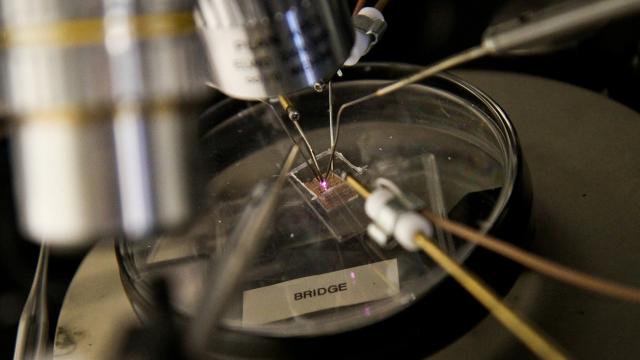The pink glow you see above is coming from the world’s smallest plasma transistor, an unfathomably minuscule device 100 times smaller than the width of a human hair. It’s not just tiny, it’s tough, and theoretically able to withstand brutal environments. And it could massively change consumer electronics.
Fabricated by Professor Massood Tabib-Azar and doctoral student Pradeep Pai at the University of Utah, this honey-I-shrunk-the-transistor is a full 500 times smaller than current state of the art microplasma devices. Transistors are the nuts and bolts of electronic devices, controlling how electricity flows in the computer chips that power every smart device you’ve ever laid hands on.
Silicon transistors are the industry standard, but they start to fall apart at temperatures over 550 degrees Fahrenheit. Plasma-based transistors use charged gases rather than physical circuits to conduct electricity. Current plasma transistors are used in medical instruments, light sources, and other high-temperature environments, but they’re energy hogs, requiring more than 300 volts of juice — nearly three times what you get from your wall outlet.
By comparison, the University of Utah team’s super-tiny transistor only needs one-sixth the voltage of larger plasma transistors, and it’s capable of surviving temps up to nearly 1,500 degrees Fahrenheit. And did we mention it’s hideously small?
Such a tiny transistor has huge implications. Tabib-Azar predicts they could allow engineers to pack an entire X-ray imaging setup into a smartphone, letting soldiers and medical technicians perform medical imaging right in the field. The tiny transistors could also be used to sense chemicals in the air. Or to make pretty much any transistor-based device you can think of monumentally smaller.
And that high-heat capability means these little guys would shrug off the temperatures generated in a nuclear reactor. “This transistor has the potential to start a new class of electronic devices that are happy to work in a nuclear environment,” Tabib-Azar says. “These plasma-based electronics can be used to control and guide robots to conduct tasks inside the nuclear reactor, [or] control nuclear reactors if something goes wrong, and also could work in the event of nuclear attack.”
Big capabilities for such a little thing. [University of Utah via PhysOrg]
Image: Dan Hixson, College of Engineering, University of Utah
